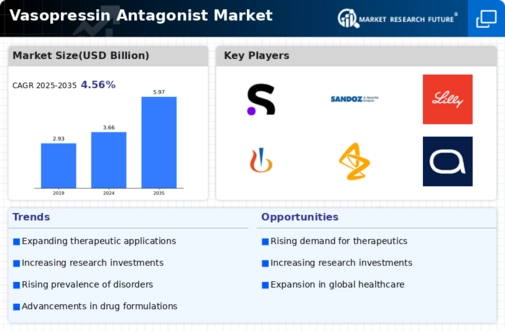Growing Geriatric Population
The expanding geriatric population is a significant factor influencing the Global Vasopressin Antagonist Market Industry. Older adults are more susceptible to conditions that lead to hyponatremia, such as chronic kidney disease and heart failure. As the global population ages, the demand for effective treatments for these conditions is expected to rise. This demographic shift is likely to drive the market, as healthcare systems adapt to meet the needs of an aging population. The Global Vasopressin Antagonist Market Industry is poised for growth, with projections indicating a market value of 3.66 USD Billion in 2024, underscoring the urgency for effective therapeutic interventions.
Advancements in Drug Development
Innovations in drug development methodologies are significantly impacting the Global Vasopressin Antagonist Market Industry. The emergence of novel vasopressin antagonists, which offer improved efficacy and safety profiles, is likely to enhance treatment outcomes for patients with conditions like hyponatremia. Recent advancements in biotechnology and pharmacology have facilitated the creation of more targeted therapies, which may lead to better patient compliance and satisfaction. As a result, the Global Vasopressin Antagonist Market Industry is expected to grow, with a projected value of 5.97 USD Billion by 2035. This growth is indicative of the industry's commitment to addressing the complexities of vasopressin-related disorders.
Rising Prevalence of Hyponatremia
The increasing incidence of hyponatremia, a condition characterized by low sodium levels in the blood, is a primary driver of the Global Vasopressin Antagonist Market Industry. As the population ages, the prevalence of conditions leading to hyponatremia, such as heart failure and liver cirrhosis, is expected to rise. This trend is particularly pronounced in developed regions, where healthcare access allows for better diagnosis and treatment. The Global Vasopressin Antagonist Market Industry is projected to reach 3.66 USD Billion in 2024, reflecting the growing demand for effective treatment options for hyponatremia. Consequently, pharmaceutical companies are focusing on developing and marketing vasopressin antagonists to address this unmet medical need.
Increasing Awareness and Diagnosis
Heightened awareness regarding the implications of vasopressin dysregulation is driving the Global Vasopressin Antagonist Market Industry. Healthcare professionals are becoming more adept at recognizing the symptoms associated with vasopressin-related disorders, leading to earlier diagnosis and treatment. This trend is supported by educational initiatives and clinical guidelines that emphasize the importance of managing conditions like hyponatremia. As awareness increases, the demand for vasopressin antagonists is likely to rise, contributing to a compound annual growth rate (CAGR) of 4.55% from 2025 to 2035. This growth reflects a broader recognition of the need for effective therapeutic options in managing these conditions.
Regulatory Support for New Therapies
Regulatory bodies are increasingly supportive of the development and approval of new vasopressin antagonists, which is a crucial driver for the Global Vasopressin Antagonist Market Industry. Streamlined approval processes and incentives for orphan drugs are encouraging pharmaceutical companies to invest in research and development. This regulatory environment fosters innovation, allowing for the introduction of new therapies that can effectively manage conditions associated with vasopressin dysregulation. As a result, the Global Vasopressin Antagonist Market Industry is likely to benefit from an influx of novel products, enhancing treatment options for patients and potentially increasing market value.
























Leave a Comment